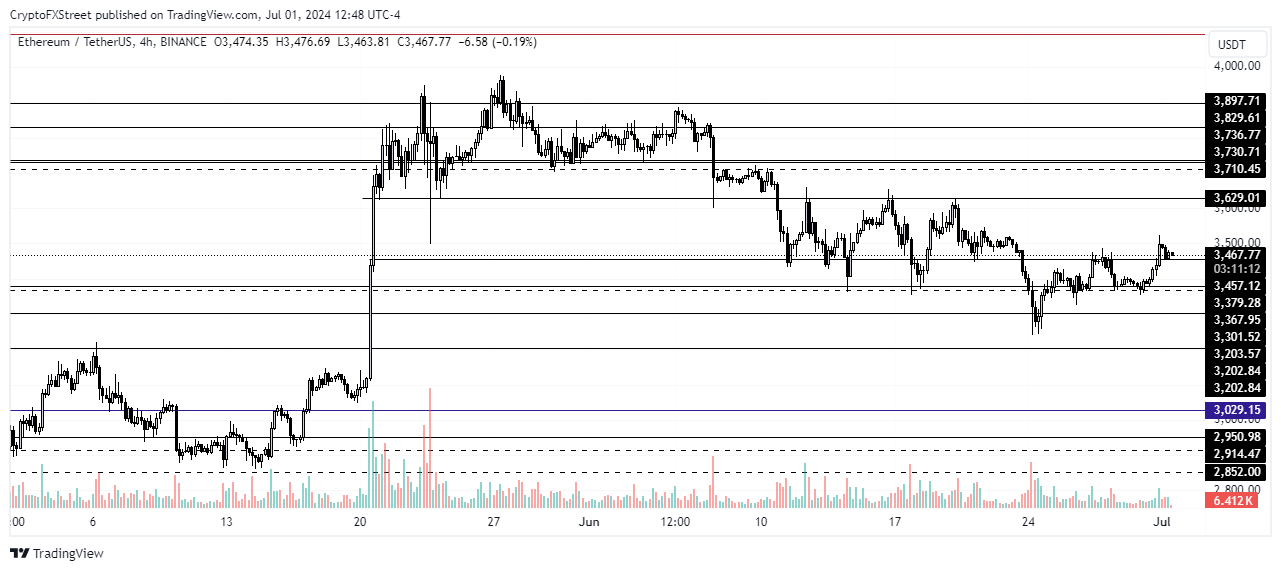Ethereum outflows amid potential US government sale of seized ETH could crush positive July projections
- Global Ethereum ETF outflows threaten expectations of successful spot ETH ETF launch.
- ICO whale and US government hint at ETH sale after recent transfers.
- Ethereum's historical July returns could attract bulls as spot ETH ETF launch draws closer.
Ethereum (ETH) is up more than 2% on Monday despite increased outflows across global ETH ETF products and exchange deposits from key whale wallets.
Daily digest market movers: Ethereum outflows, whale transfers
In an X post on Monday, Nate Geraci, President of the ETF Store, predicted that spot Ethereum ETFs would be the second most successful ETF debut in history behind spot Bitcoin ETFs.
However, flows across international Ethereum investment products suggest otherwise. According to CoinShares, global Ethereum ETFs saw outflows of $61 million last week, its highest since August 2022. This pushes its two-week net flows to $119 million in outflows.
CoinShares noted that the move places ETH as the worst-performing digital asset this year in terms of net flows. ETH net flows could turn positive in the coming weeks if the Securities & Exchange Commission (SEC) approves the S-1 drafts of issuers in the US.
The SEC approved 19b-4 filings of prospective spot ETH ETF issuers on May 23 but also needs to greenlight their S-1 registration statements before the ETFs can begin trading.
According to Wu Blockchain, an ICO-era whale moved 7K ETH worth $24.8 million to Kraken exchange within the past 24 hours after staying silent for 209 days. The whale wallet still has more than 40K ETH, worth about $139.5 million, within its possession. Notably, the whale purchased 254.9K ETH at an average price of $0.311 during its ICO in 2014.
Historically, long-term holders becoming active often indicates that the market is approaching the peak of a bull cycle.
Additionally, an address linked to the US government transferred 3,375 ETH to an unknown address, according to Arkham Intelligence. The address contains the seized funds of Estonia duo Potapenko and Turogin, who were extradited to the US for an alleged $575 million Ponzi scheme.
ETH technical analysis: Ethereum's historical July returns may attract bulls
Ethereum is trading around $3,469, up over 2% in the past 24 hours, as the crypto market looks set for a recovery. The price increase wiped more than $20 million worth of ETH short positions off the market, while long positions only saw minor liquidations of about $4 million.
Ethereum's positive start to the month aligns with its average July returns since its launch. Coinglass data shows Ethereum has an average return of 6.28% in the month. In the past four years, the number one altcoin has only ended July on a loss in 2023.

ETH/USDT 4-hour chart
In addition, Ethereum looks poised for growth as spot ETH ETFs may launch in the coming days. As a result, ETH could test the $3,629 resistance, which it had failed to sustain a move above in the past three weeks. A breach of the $3,203 key support would invalidate the bullish thesis.
Ethereum FAQs
Ethereum is a decentralized open-source blockchain with smart contracts functionality. Serving as the basal network for the Ether (ETH) cryptocurrency, it is the second largest crypto and largest altcoin by market capitalization. The Ethereum network is tailored for scalability, programmability, security, and decentralization, attributes that make it popular among developers.
Ethereum uses decentralized blockchain technology, where developers can build and deploy applications that are independent of the central authority. To make this easier, the network has a programming language in place, which helps users create self-executing smart contracts. A smart contract is basically a code that can be verified and allows inter-user transactions.
Staking is a process where investors grow their portfolios by locking their assets for a specified duration instead of selling them. It is used by most blockchains, especially the ones that employ Proof-of-Stake (PoS) mechanism, with users earning rewards as an incentive for committing their tokens. For most long-term cryptocurrency holders, staking is a strategy to make passive income from your assets, putting them to work in exchange for reward generation.
Ethereum transitioned from a Proof-of-Work (PoW) to a Proof-of-Stake (PoS) mechanism in an event christened “The Merge.” The transformation came as the network wanted to achieve more security, cut down on energy consumption by 99.95%, and execute new scaling solutions with a possible threshold of 100,000 transactions per second. With PoS, there are less entry barriers for miners considering the reduced energy demands.

